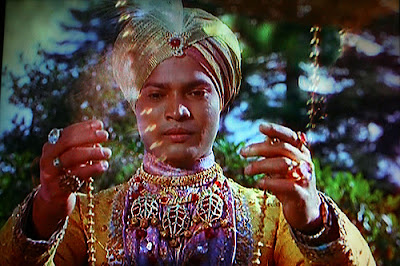 Black Narcissus (Michael Powell and Emeric Pressburger, 1947) God in heaven, this is one of the most beautiful movies ever made. In fact, this might be the contender that beats Gone With the Wind as the most gorgeous movie ever to be made from trashy material.*
Black Narcissus (Michael Powell and Emeric Pressburger, 1947) God in heaven, this is one of the most beautiful movies ever made. In fact, this might be the contender that beats Gone With the Wind as the most gorgeous movie ever to be made from trashy material.* I haven't read the book "Black Narcissus" by Rumer Godden, so it's premature and ignorantly judgmental to call it trash, but the evidence from the film—a lust triangle between a pair of nuns and the only white man in the Himalayan neighborhood is soapy to the point of leaving rings around your eyes. It does bring up the conflicts of those devoted to faith when confronted with Earthly desires, and how tough it is for physical beings to be married to Christ when he's an absentee husband. It's just that, dramatically, the conflict is presented so turgidly as to approach the giggle reflex, despite being performed by (rather bravely, I think, or foolhardedly) the former lover of the director, Deborah Kerr, and his current lover, Kathleen Bryon (interestingly, she played the wife of elderly James Ryan in the Framing sequences in Spielberg's Saving Private Ryan), who present subtlety and hysteria (the latter, approaching Exorcist-like possession).
There is that contrast, front and center, but there are also the ones between Western faith and Eastern spiritualism in the parallel stories of the nuns (and their duties and desires) and the demands of a local girl (Jean Simmons—uh, yeah, Indian by way of Crouch Hill, London) and her arranged marriage to a young prince (Sabu), and in marked contrast to a monk who lives his life, hermit-like and with no distractions to his faith. There is some validity to the total for that, although the nuns and their belief system come out poorly in the comparison.
What is NOT in conflict (and makes it a must-see no matter the subject matter) is that Black Narcissus is one of the most beautiful movies ever made, in large part due to director Powell, production designer Alfred Junge, the amazing cinematographer Jack Cardiff, but also process shooter W. Percy Day and a young up-and-comer by the name of Peter Ellenshaw, who would create a lot of legendary magic for Disney over the years).
The photo-chemical wonders accomplished by these men is mesmerizing—one of those rare films (like The Leopard or Barry Lyndon) that you could take any frame and hang it on a wall.
The Technicolor palette pops and not subtly, and images are rich and lush, evoking a sensuality far beyond what the script calls for or evokes. Powell once said, "Sometimes in a film its theme or its colour are more important than the plot." That's certainly true of Black Narcissus. There is a sumptuous quality to the images whether they suggest the bare asceticism of the nun's cloister or the natural wildness of the Himalayan landscape (incredibly, the film was shot at Pinewood Studios and Leonardslee Gardens, West Sussex, the home of a retired Indian Army officer), the planes of the faces (Cardiff could photograph women like no other), reflected in love or contorted in hate, the warm peace of a Himalayan glade, or the terrifying verticality of the nun's cliff-side perch.
That cliff telegraphs events in the film like a deus escarpment, which manages events and resolves conflicts in a very (shall we say?) orthodox manner. Let's just say that "falling" is a major theme of the film, which manages to maintain its own balance by the strength and audacity of its images.
.jpg)




.jpg)













No comments:
Post a Comment